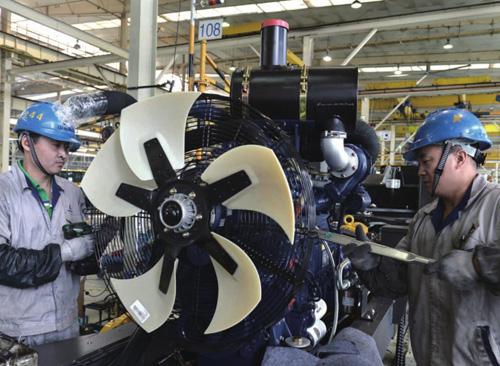Path to Inclusive Globalization
2018-05-14ByLiuWeidong
By Liu Weidong

The rise of protectionism in recent years has accompanied dramatic changes taking place in the world and has left global leaders and scholars anxious about the future of globalization. Since the 2008 international fi nancial crisis and especially after 2016, the globalization trend has taken a sudden downturn marked by Brexit and a series of protectionist policies implemented by the United States. Once stalwart champions of free trade and globalization, the United States and the United Kingdom both took a step back, causing the locomotive of globalization to lose power and switch tracks.
Against this backdrop, the Belt and Road Initiative proposed by China has become an anchor for the precarious global economy and a propeller for the reform and development of globalization. Five years ago when the initiative was fi rst proposed, China was aiming to improve the global economic governance system. Now, changes in the global context have objectively raised the initiatives importance to new heights. It has become a platform for an increasing number of heads of state and governments to explore new modes of global economic governance. In short, the initiative is leading a new type of more inclusive globalization.
The term “inclusive globalization” is an immanent critique of the neoliberal globalization of the past 30 to 40 years, featuring both similarities and differences. Inclusive globalization does not involve deglobalization or a reversal of globalization but rather an active evolution and reform. The fundamental difference between the two is that inclusive globalization is designed fi rst and foremost to improve peoples livelihoods rather than only to serve the interests of capital.
Inclusive growth
In research and practice of both global and national development, the relationship between markets and government intervention has been a consistent focus. An inclusive growth model requires a more active state to avoid becoming subservient to the needs of capital accumulation, with greater emphasis on social equity, environmental sustainability and improved governance capacity.
First, governments need to strengthen international cooperation to address global challenges such as turbulence in financial markets, climate change and other global issues. Second, countries need to strengthen the protection of ordinary people and increase the living standards of the poor through training and education, targeted poverty alleviation, mass entrepreneurship and innovation, job creation, infrastructure provision and other measures. Third, a country needs to be able to guide the allocation of fi nancial resources and provide basic, reliable and affordable public services.
The Belt and Road Initiative attaches great importance to the role of governments, emphasizing interactive bilateral and multilateral policy coordination; alignment of development strategies, plans and projects; and a proactive search for areas of agreement and mutual benefi t. The aim is not just to meet the need of capital expansion, but to do so in ways that meet the needs of less developed regions and ordinary people, spread the benefits to more regions and more people, and provide for inclusive, win-win adjustment.
Inclusive infrastructure
Providing reliable and affordable infrastructure to less developed areas and countries is key to their growth. Many studies have shown that connectivity is a prerequisite for regions to benefi t from economic globalization opportunities. Moreover, investing in infrastructure bottlenecks can spur economic growth and provide social and financial returns. Although modern infrastructure has linked many parts of the globe, making the world smaller in many ways, many regions and their people still lack full access to a modern infrastructure system. Even in some developed countries such as the United States, infrastructure has become outdated and dilapidated due to a lack of investment.
These problems are closely related to changes in national and global capital markets which began in the 1980s. Over the past 25 years, regional banks and traditional savings organizations have lost out to new financial intermediaries such as pension funds, mutual funds, sovereign wealth funds, and funds from private corporations and certain types of insurance companies. The fundamental problem is that the funds supplied by these financial intermediaries are more likely to be invested in speculative or short-term investment markets. Hot money that fl ows from one country to another to earn short-term profi ts and hedge fund institutions are prime examples.
Infrastructure projects are, however, large-scale and capital-intensive with long turnover times and payback periods that require patient long-term funding. The gap between these needs and the predominance of short-term fi nancing led scholars like Justin Yifu Lin to emphasize the serious“maturity mismatch” in the global infrastructure financing market and the need for more “patient capital.” One of the Belt and Road Initiatives priorities is substantial infrastructure financing to accelerate access to modern infrastructure networks in less developed countries and regions and provide opportunities for development. This provision, which allows for patient capital, is one of the important reasons why the Belt and Road Initiative has been welcomed by many developing countries.
Inclusive development
Globalization does not require a unifi ed development model; promoting the so-called “best practices” and established formulas for development should be abandoned. Since the 1980s, the United States, the UK and other countries have sought to transfer neoliberal ideals and policies, which are often loaded with conditions, to developing countries. In the late 1980s, the Washington Consensus emerged as a set of policy prescriptions adopted by U.S.-based institutions such as the International Monetary Fund and the World Bank and the U.S. Treasury Department. In the 1990s, these, and sometimes an even wider set of neoliberal measures, were imposed on countries in need of fi nancial assistance. At least until the global fi nancial crisis of 2008, the World Bank had peddled a set of“best practices” to developing countries, the essence of which was privatization, marketization and liberalization.
Nearly two decades of history have shown that almost all the countries that were forced to follow the Washington Consensus recipe were subsequently mired in serious economic diffi culties and lost their economic independence, which was in fact an untold objective of the measures. China did not adopt these standard prescriptions, although it was frequently recommended by this grouping, but never successfully imposed. Instead, China explored its own development path of“crossing the river by feeling the stones.”As a result, it achieved rapid and sustained economic growth.
It is precisely for this reason that, unlike the neoliberal globalization model, the Belt and Road Initiative does not involve the identifi cation of one best development path. Instead, it stresses that each country should choose a development path that suits its own conditions. At the Belt and Road Forum for International Cooperation in May 2017, Chinese President Xi Jinping noted that China has no intention of interfering in other countries internal affairs or exporting its own model of development, but rather seeks to achieve a new model of win-win cooperation.
Inclusive participation
The very concept of inclusive globalization embodies the notion that it involves all countries and all people of the world. Although major powers are the catalysts of globalization, all countries should have the basic right to equal participation. In historical experiences of global economic expansion, powerful countries exercised hegemonic influence. The expansion of colonial trade was dominated by the Portuguese, Spanish and Dutch, followed by a wave of imperial expansion led by the UK and subsequently the United States. The liberal international order dominated by Western countries has been associated with an extremely unequal system of international trade and investment. In the last phase of economic globalization, multinational corporations and Western-dominated international organizations exercised extraordinary power, leaving many countries in a weak negotiating position. A key issue in promoting an inclusive path while further advancing globalization involves methods to care for the weak and limit the dominant infl uence of great powers.
The Belt and Road Initiative adheres to the principles of “openness, inclusiveness, equality and mutual benefits,” as well as that of “achieving shared growth through negotiation and collaboration.” It places the largest common development factor atop the agenda and gives priority to joint development and common prosperity. Moreover, the initiative is neither confi ned to a small group nor to groups with one set of beliefs or social values. The initiative upholds open-mindedness and welcomes all interested countries and regions to participate in appropriate ways on equal footing. The Joint Communiqué of the Leaders Roundtable of the Belt and Road Forum for International Cooperation specifically emphasized the need for special attention to the least developed countries, landlocked developing countries, small island developing states and other such parties. These players are the cornerstones of a strong and inclusive Belt and Road Initiative.
Cultural inclusiveness
Over the past three centuries, Western European and North American countries have emerged as developed countries and colonial/ imperial powers, occupying a leading position in the global economic order. These Western countries developed self-centric ideologies and a sense of cultural superiority, under which many developing countries have been left with a sense of cultural inferiority. The consequences of the dominance of Western doctrine and cultural superiority are detrimental to global sustainable development.
The ancient Silk Roads principle of mutual respect and mutual learning upheld completely different cultural values. The Belt and Road Initiative also venerates the Silk Road spirit, respecting cultural differences and emphasizing the principles of common development and common prosperity on the basis of the preservation of cultural pluralism and shared peace. President Xi has repeatedly stressed that the Belt and Road Initiative does not involve an ideological or political agenda. Through equal exchange and mutual learning, cultures have become more colorful and more innovative.
